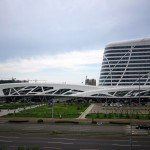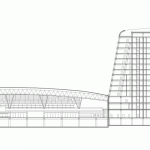Daqing Highway Passenger Transportation Hub – Had Architects – China
Architects: Had Architects
Location: Daqing, Heilongjiang, China
Design Team: Tang Jiajun, Wang Conglong, Ji Qiang
Area: 29,576 sqm
Year: 2010
Photographs: Wei Shuxiang and Tang Jiajun
Daqing Highway Passenger Transportation Hub is in the intersection between Century Avenue and Longfeng Street. Its main building consist of a three-storey station house and a fourteen-storey information center, and they are connect together harmoniously. The overall project construction area is nearly 30,000 square meters, and is designed in early 2009, completed in late 2010.
Daqing City is famous for China’s largest oil city, and it is located in the northern alpine zone, which has great geographical features. In this case we try to breakthrough the traditional traffic building mode, and give the passenger building some cultural connotations. So the shape of building is from the ice and snow culture, and considered Northeast snowy landform features, white shapes post and down like winter hill standing above the earth, which have beautiful profile. The details of the building facade form like branch with steel structure, so enrich the level of the facade and also strengthen the design concept. The interior space of passenger transportation highlights the open and transparent feelings, with a three-storey hall, which linked the function of each space, providing a good flow line and great view.
The passenger transportation building is made mainly with steel structure, and set some of the concrete structure. The steel structure is the way to achieve the complex facade shape and large-span roof. And the steel structure combine with concrete structure to support the formation of a stable structural system.
- Daqing Highway Passenger Transportation Hub – Had Architects – China
- Daqing Highway Passenger Transportation Hub – Had Architects – China
- Daqing Highway Passenger Transportation Hub – Had Architects – China
- Daqing Highway Passenger Transportation Hub – Had Architects – China
- Daqing Highway Passenger Transportation Hub – Had Architects – China
- Daqing Highway Passenger Transportation Hub – Had Architects – China
- Daqing Highway Passenger Transportation Hub – Had Architects – China
- Daqing Highway Passenger Transportation Hub – Had Architects – China
- Daqing Highway Passenger Transportation Hub – Had Architects – China
- Daqing Highway Passenger Transportation Hub – Had Architects – China
- Daqing Highway Passenger Transportation Hub – Had Architects – China
- Daqing Highway Passenger Transportation Hub – Had Architects – China
Source: Archdaily

















No Comments